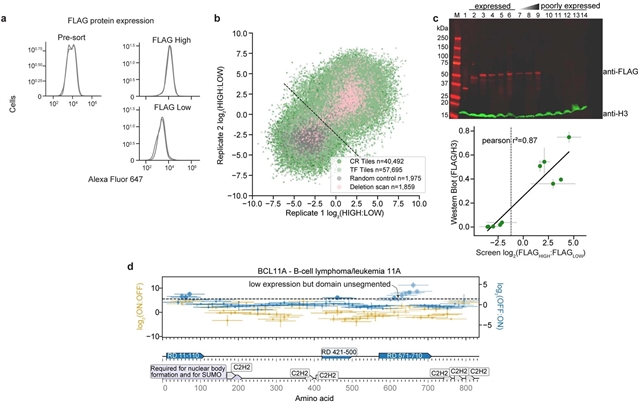
美国斯坦福大学Lacramioara Bintu小组实现人类转录效应结构域的大规模测绘和诱变。相关论文于2023年4月5日在线发表在《自然》杂志上。
研究人员系统地测量了人类细胞中大多数染色质调节因子和转录因子(2047个蛋白)的10万多个蛋白片段的效应器活性。通过测试它们在报告基因上招募时的效果,研究人员注释了374个激活结构域和715个抑制结构域,其中大约80%是新的和以前没有被注释过的。对所有效应结构域的合理诱变和缺失扫描显示,芳香族和/或亮氨酸残基与酸性、脯氨酸、丝氨酸和/或谷氨酰胺残基穿插在一起,是激活结构域活性所必需。
此外,大多数压制结构域序列包含小泛素样修饰物(SUMO)阳性的位点,可用于招募核心抑制物的短互动模体,或者是招募其他抑制蛋白的结构化结合结构域。研究人员发现了既能激活又能抑制的双功能域,其中一些能将细胞群动态地分成高表达和低表达的亚群。研究人员对效应结构域进行了系统的注释和表征,为了解人类转录因子和染色质调节器的功能、控制基因表达的工程化紧凑型工具以及完善效应结构域功能的预测模型提供了丰富的资源。
据悉,人类的基因表达受2000多个转录因子和染色质调节因子的调节。这些蛋白中的效应域可以激活或抑制转录。然而,对于许多这样的调节因子,人们不知道它们包含什么类型的效应结构域,它们在蛋白质中的位置,它们的激活和抑制强度,以及它们功能所必需的序列。
附:英文原文
Title: Large-scale mapping and mutagenesis of human transcriptional effector domains
Author: DelRosso, Nicole, Tycko, Josh, Suzuki, Peter, Andrews, Cecelia, Aradhana, Mukund, Adi, Liongson, Ivan, Ludwig, Connor, Spees, Kaitlyn, Fordyce, Polly, Bassik, Michael C., Bintu, Lacramioara
Issue&Volume: 2023-04-05
Abstract: Human gene expression is regulated by more than 2,000 transcription factors and chromatin regulators1,2. Effector domains within these proteins can activate or repress transcription. However, for many of these regulators we do not know what type of effector domains they contain, their location in the protein, their activation and repression strengths, and the sequences that are necessary for their functions. Here, we systematically measure the effector activity of more than 100,000 protein fragments tiling across most chromatin regulators and transcription factors in human cells (2,047 proteins). By testing the effect they have when recruited at reporter genes, we annotate 374 activation domains and 715 repression domains, roughly 80% of which are new and have not been previously annotated3,4,5. Rational mutagenesis and deletion scans across all the effector domains reveal aromatic and/or leucine residues interspersed with acidic, proline, serine and/or glutamine residues are necessary for activation domain activity. Furthermore, most repression domain sequences contain sites for small ubiquitin-like modifier (SUMO)ylation, short interaction motifs for recruiting corepressors or are structured binding domains for recruiting other repressive proteins. We discover bifunctional domains that can both activate and repress, some of which dynamically split a cell population into high- and low-expression subpopulations. Our systematic annotation and characterization of effector domains provide a rich resource for understanding the function of human transcription factors and chromatin regulators, engineering compact tools for controlling gene expression and refining predictive models of effector domain function.
DOI: 10.1038/s41586-023-05906-y
Source: https://www.nature.com/articles/s41586-023-05906-y
Nature:《自然》,创刊于1869年。隶属于施普林格·自然出版集团,最新IF:69.504
官方网址:http://www.nature.com/
投稿链接:http://www.nature.com/authors/submit_manuscript.html
